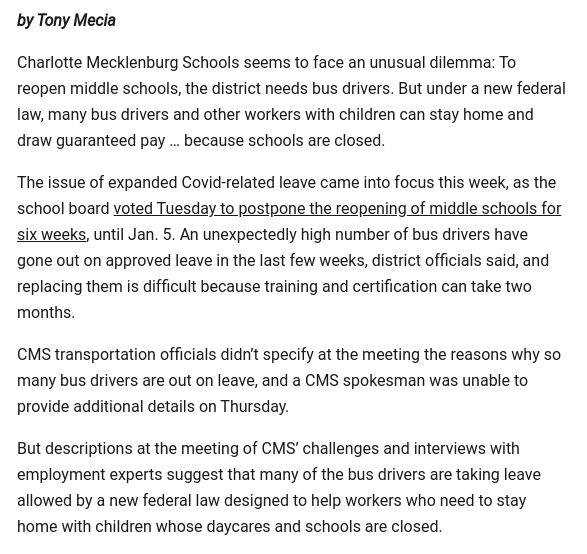
So @anniema15 interviewed @JenniferforCMS and @Sawyer4Schools who are advocating for @CMSSupt to push @CMSboard and @CharMeckSchools away from "hybrid learning" for elementary to full-remote for all.
It's really important that you read this.
charlotteobserver.com/news/local/edu…
It's really important that you read this.
charlotteobserver.com/news/local/edu…
I have a few highlights, and a few thoughts.
First, it's clear that we all agree that utilizing arbitrary community metrics is unnecessary, as @Sawyer4Schools herself alludes to here.
First, it's clear that we all agree that utilizing arbitrary community metrics is unnecessary, as @Sawyer4Schools herself alludes to here.

BTW: The answer to Sawyer's rhetorical is when the metrics were created, people didn't understand that open schools weren't the problem, and closed schools aren't the solution.
Now we know that preemptive school closures have little benefit and cause significant harm.
Now we know that preemptive school closures have little benefit and cause significant harm.
In fact, UNICEF studied data from 191 countries, and said this:
"Schools are not a main driver of community transmission, and children are more likely to get the virus outside of school settings."
politico.com/states/new-jer…
"Schools are not a main driver of community transmission, and children are more likely to get the virus outside of school settings."
politico.com/states/new-jer…
And, @ProfEmilyOster has data covering more than 200,000 students from 47 states. Her conclusion thus far?
Case rates among elementary and middle school staff & students is LOWER than the overall community case rate. In high school staff & students, it's about the same.
Case rates among elementary and middle school staff & students is LOWER than the overall community case rate. In high school staff & students, it's about the same.

This means that kids, and staff, at elementary and middle schools, are MORE likely to get infected in the community than they are in a school setting.
For high school students, they're just as likely to get infected in the community as in school.
For high school students, they're just as likely to get infected in the community as in school.
Kids (and teachers) are safer in school than they are outside of school. It's easier to control their number of contacts, their daily routines, in a school setting than outside of school.
Even the New York Times understands this.
Schools "do not seem to be stoking community transmission." Notably, "Elementary schools especially seem to seed remarkably few infections."
nytimes.com/2020/10/22/hea…
Schools "do not seem to be stoking community transmission." Notably, "Elementary schools especially seem to seed remarkably few infections."
nytimes.com/2020/10/22/hea…
And we now know that, all over the world, case rates have come under control, with all sorts of different interventions, without closing schools.
https://twitter.com/apsmunro/status/1334896586170769410?s=20
In fact, six governors recently issued a joint statement, noting that in-person learning is safe "even in communities with high transmission rates."
https://twitter.com/GovMurphy/status/1329444474016198662?s=20
So, we know that there is little (if any) expected benefit from school closures.
What are the risks associated with keeping schools closed?
I would've really liked if @anniema15 asked @Sawyer4Schools and @JenniferforCMS this question.
I'll answer it, though.
What are the risks associated with keeping schools closed?
I would've really liked if @anniema15 asked @Sawyer4Schools and @JenniferforCMS this question.
I'll answer it, though.
"Keeping schools closed for young children is causing lasting and needless damage."
https://twitter.com/LisaPatelMD/status/1334924626984456197?s=20
"The risks of kids out of school are escalating rapidly. Literacy, learning, nutrition, socialization, abuse/neglect. Disparities widening across race, income, gender."
https://twitter.com/j_g_allen/status/1333824273224491013?s=20
"When Sars cov 2 is over, we will have to deal with the damage done to school kids-- disproportionately poor and minority kids deprived of school for months-- this damage will haunt us for the rest of my life and deeply scar the social fabric."
https://twitter.com/VPrasadMDMPH/status/1334684302425038848?s=20
"Nationally, roughly 40,000 additional instances of child maltreatment would have been confirmed were it not for school closures" according to an NIH paper.
IN MARCH AND APRIL ALONE
ncbi.nlm.nih.gov/pmc/articles/P…
IN MARCH AND APRIL ALONE
ncbi.nlm.nih.gov/pmc/articles/P…

“It is very clear to everyone what the downsides are to having school closures,” Helve said. “The downside to closing would need to be compensated by an extremely good outcome in terms of disease control, and it doesn’t seem to do that.”
washingtonpost.com/world/europe/e…
washingtonpost.com/world/europe/e…
Last month, @drwilvancleve and @DAChristakis tried to quantify the life years lost due to school closures.
"This decision analytical model found that missed instruction during 2020 could be associated with an estimated 5.53 million years of life lost."
jamanetwork.com/journals/jaman…
"This decision analytical model found that missed instruction during 2020 could be associated with an estimated 5.53 million years of life lost."
jamanetwork.com/journals/jaman…
In summary, school closures offer little (if any) benefit, and significant risks.
If @Sawyer4Schools and @JenniferforCMS push to close schools, it would be like a physician prescribing strong doses of chemotherapy for a patient who doesn't have cancer.
If @Sawyer4Schools and @JenniferforCMS push to close schools, it would be like a physician prescribing strong doses of chemotherapy for a patient who doesn't have cancer.
Schools remain open in our city, as in many, for private school students. Those will not preemptively close. Public schools shouldn't either.
@threadreaderapp unroll
• • •
Missing some Tweet in this thread? You can try to
force a refresh



